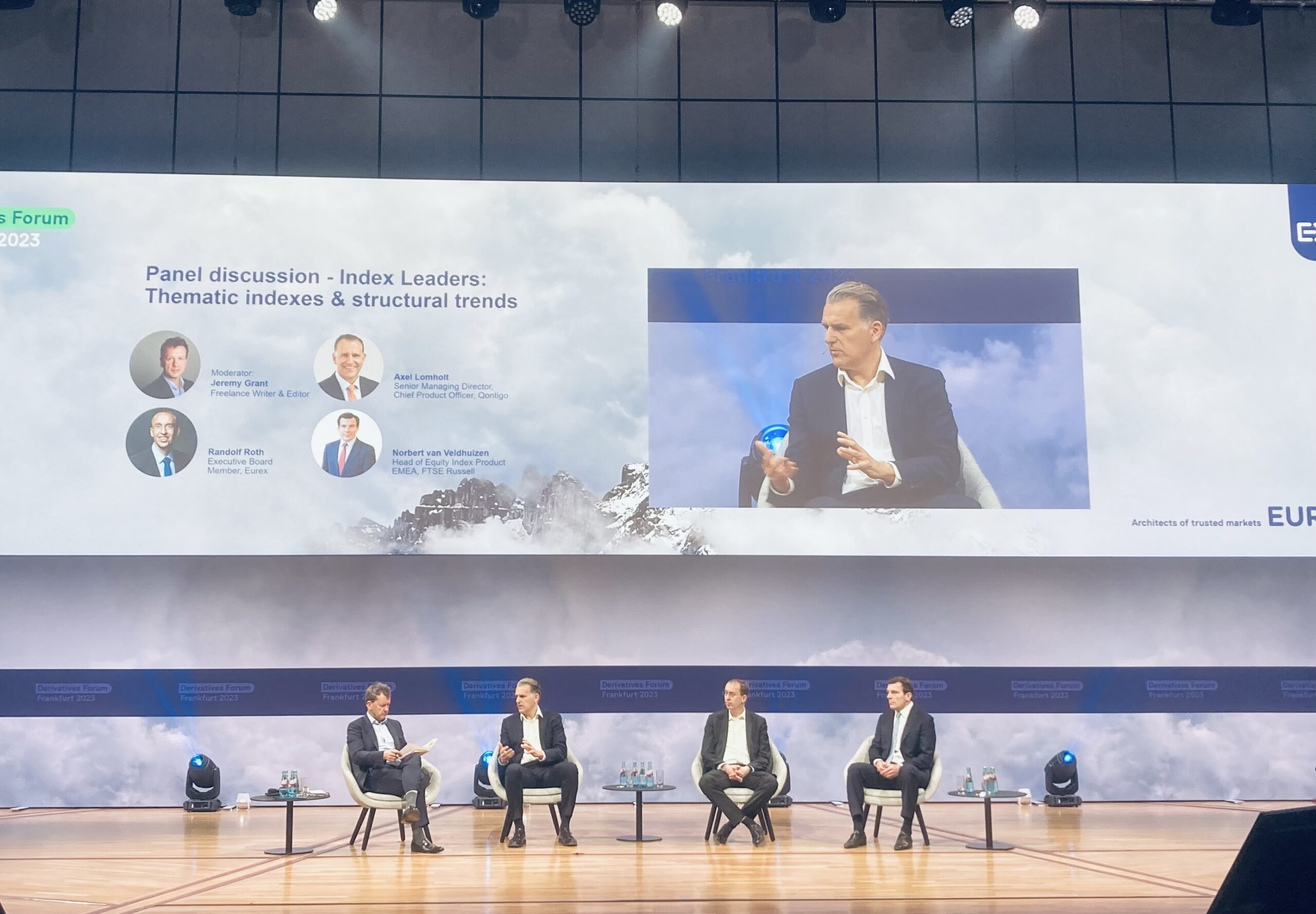A panel at the recent Eurex Derivatives Forum explored the boom in thematic investing, analyzing the drivers behind strong demand for ETFs and why thematic futures may become the next growth segment in exchange-traded derivatives.
According to Qontigo’s Axel Lomholt, thematic strategies have been underpinned by a major transformation in the investing landscape, which includes technological advancements, the growth of the ETF and online platforms, and a new cohort of young investors who are drawn to the economic and social implications of megatrends changing our modern world.
“Technology over the past 20 years has completely transformed the way we can build portfolios,” said Lomholt, Chief Product Officer at Qontigo, general manager of STOXX and DAX indices. “And then you think about the way retail investors are buying financial products – that’s extremely different from 20 years ago.”
“You’ve got to make sure that you are capturing a theme” in the right way, he said. “That’s why it is important that you can work with someone like Eurex because you want to be sure that you have the capital markets that will support you.”

Despite a negative market backdrop, 185 thematic ETFs were introduced in 2022 around the world, or 23% of total launches.1 Passive thematic ETFs lured a net 39 billion euros over the twelve months, even as many of the growth-oriented products suffered a decline in prices.
Eurex introduced futures on the STOXX® Global Breakthrough Healthcare, STOXX® Global Digitalisation and STOXX® Global Digital Security indices last year. While trading volumes in the products are yet to take off, liquidity will eventually increase to support trading and hedging in the growing thematic ETF space, Randolf Roth, Executive Board Member at Eurex, said during the debate.
“Thematics is the next step in a long journey,” said Roth. “It started with national indices, then the pan-European and global indices, and then sector indices. We managed to make most of them very liquid. ESG also came, and now thematics come as a sort of natural evolution of the ESG topic as well as of sectors.”
“For the index provider, the ball is in the penalty area,” Roth said. “For us, as an exchange, it is in the mid-field right now, because we need to create liquidity. We have listed the products, we want to be at the front of development, but it will take a while.”
Those comments were echoed by Serkan Batir in another panel at the same event. Qontigo’s Global Head Index Product Development told the audience that it is often the case that the launch of ETFs leads to the listing of derivatives. While that trend started with benchmarks such as the EURO STOXX 50®, Batir explained, a similar pattern is unfolding with more targeted strategies.
What is happening on the thematics side mirrors the development of sector investing some years ago, said Batir. “It takes a bit of time on the education side, and thematics are seen as a riskier investment compared to sectors,” he said. “Demand is coming from the ecosystem of ETFs, market makers, product providers, and that helps drive liquidity and simplify trading of the product.”
Themes vs. sectors
The debate moved on to the advantages of investing on themes as opposed to traditional sectors. Thematic strategies cross the established boundaries of more conventional region-, country- or sector-based offerings. Sectors are often too broad to enable targeted investments: for example, an investor seeking specific exposure to chipmakers would be loaded up with multiple unwanted business segments if they bought a technology sector ETF.
“There are new activities that cannot be captured in a sector classification,” Norbert van Veldhuizen, Head of Equity Index Product EMEA at FTSE, told the Forum’s audience. “We need to have more agile systems to identify those companies and their activities. Whether it is revenues or investments in R&D, you need more flexibility, more agile classification systems.”
The AI data machine
The speakers also touched upon the role of artificial intelligence in designing and building new indices.
“AI helps us get the information out of the data, whether it is more objective or subjective in nature,” said FTSE’s Van Veldhuizen. “Over the next few years there will be tons of data available, generated not by humans but by AI. That’s shaping the industry, and it’s important for index providers to have more flexibility to build thematic indices.”
“The key point is subjective analysis,” added Qontigo’s Lomholt. “We all have lots of systems that can analyze data. I think what we are moving into is, how do you analyze text? How do you analyze patents? This is where AI comes in.”
Unfolding themes
The use of patents’ information is one example of technological innovation that has led to new thematic indices in recent months. At the panel, there was agreement on which themes are likely to continue garnering the most interest. The speakers mentioned technology-related topics including cybersecurity, and themes around climate change and the environment.
“Especially for the younger generations, a megatrend like climate change is something that can be experienced today,” said Van Veldhuizen. “That’s where we as index providers have the responsibility to evolve and innovate, and to come up with new solutions, to build newer and better products for investors.”
The topic of thematics will continue to dominate the conversation in the ETF industry, as the pace of innovation and emerging investable themes shows no sign of abating. In this sense, the thematic indices panel at the Eurex Derivatives Forum provided an insightful glance at the work of leading index providers.
1 According to Qontigo data.
